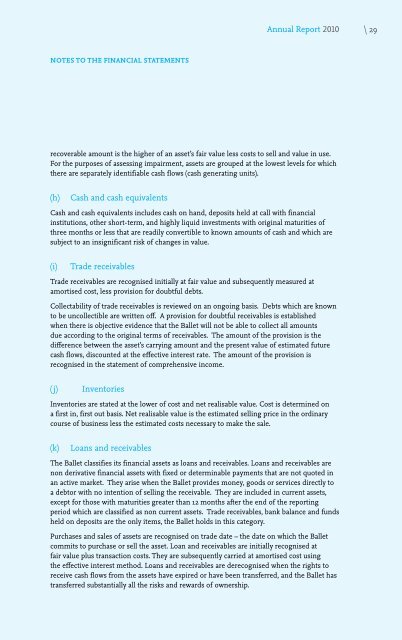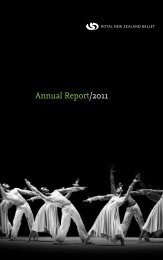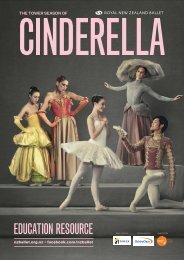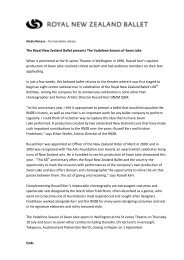Annual Report 2010 - Royal New Zealand Ballet
Annual Report 2010 - Royal New Zealand Ballet
Annual Report 2010 - Royal New Zealand Ballet
- No tags were found...
Create successful ePaper yourself
Turn your PDF publications into a flip-book with our unique Google optimized e-Paper software.
<strong>Annual</strong> <strong>Report</strong> <strong>2010</strong>\ 29NOTES TO THE FINANCIAL STATEMENTSrecoverable amount is the higher of an asset’s fair value less costs to sell and value in use.For the purposes of assessing impairment, assets are grouped at the lowest levels for whichthere are separately identifiable cash flows (cash generating units).(h)Cash and cash equivalentsCash and cash equivalents includes cash on hand, deposits held at call with financialinstitutions, other short-term, and highly liquid investments with original maturities ofthree months or less that are readily convertible to known amounts of cash and which aresubject to an insignificant risk of changes in value.(i)Trade receivablesTrade receivables are recognised initially at fair value and subsequently measured atamortised cost, less provision for doubtful debts.Collectability of trade receivables is reviewed on an ongoing basis. Debts which are knownto be uncollectible are written off. A provision for doubtful receivables is establishedwhen there is objective evidence that the <strong>Ballet</strong> will not be able to collect all amountsdue according to the original terms of receivables. The amount of the provision is thedifference between the asset’s carrying amount and the present value of estimated futurecash flows, discounted at the effective interest rate. The amount of the provision isrecognised in the statement of comprehensive income.(j)InventoriesInventories are stated at the lower of cost and net realisable value. Cost is determined ona first in, first out basis. Net realisable value is the estimated selling price in the ordinarycourse of business less the estimated costs necessary to make the sale.(k)Loans and receivablesThe <strong>Ballet</strong> classifies its financial assets as loans and receivables. Loans and receivables arenon derivative financial assets with fixed or determinable payments that are not quoted inan active market. They arise when the <strong>Ballet</strong> provides money, goods or services directly toa debtor with no intention of selling the receivable. They are included in current assets,except for those with maturities greater than 12 months after the end of the reportingperiod which are classified as non current assets. Trade receivables, bank balance and fundsheld on deposits are the only items, the <strong>Ballet</strong> holds in this category.Purchases and sales of assets are recognised on trade date – the date on which the <strong>Ballet</strong>commits to purchase or sell the asset. Loan and receivables are initially recognised atfair value plus transaction costs. They are subsequently carried at amortised cost usingthe effective interest method. Loans and receivables are derecognised when the rights toreceive cash flows from the assets have expired or have been transferred, and the <strong>Ballet</strong> hastransferred substantially all the risks and rewards of ownership.









